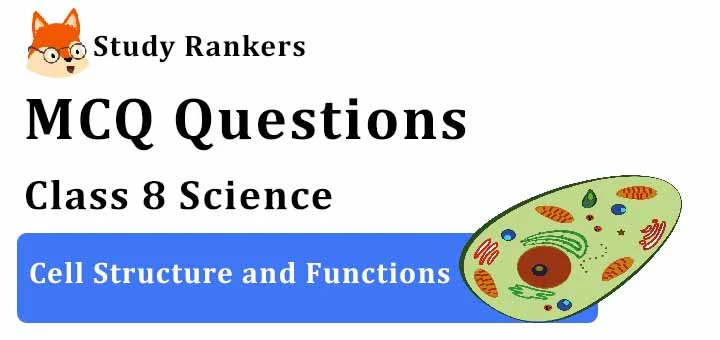MCQ Questions for Class 8 Science: Ch 8 Cell Structure and Functions

1.Which of the following cells can change its shape
(a) White blood cell
(b) Egg cell
(c) Red blood cell
(d) All of the above
► (a) White blood cell
2. What are pseudopodia?
(a) Eye of amoeba
(b) False feet of amoeba
(c) Heart of amoeba
(d) Vacuole of amoeba
► (b) False feet of amoeba
3. Vacuoles of plant cells are
(a) permanent
(b) semi-permanent
(c) temporary
(d) impermeable
► (a) permanent
4. Tissue is a
(a) Group of organs
(b) Group of cells
(c) Group of tissues
(d) Group of organisms
► (b) Group of cells
5. Which of the following is a saclike structure that store food, wastes and water?
(a) Lysosomes
(b) Centrosomes
(c) Chromosomes
(d) Vacuoles
► (d) Vacuoles
6. Which of the following is absent in an animal cell?
(a) Cytoplasm
(b) Nucleus
(c) Cell membrane
(d) Cell wall
► (d) Cell wall
7. Which of the following given below is in the ascending order of the number of nuclei present in cells?
(a) Paramoecium, brain cell, RBC of mammals.
(b) RBC of mammals, brain cell, paramoecium.
(c) Brain cell, RBC of mammals, paramoecium.
(d) All of these
► (b) RBC of mammals, brain cell, paramoecium.
8. Power house of the cell is :
(a) mitochondria
(b) chloroplast
(c) ribosome
(d) nucleus
► (a) mitochondria
9. Which of the following tissues include blood cell?
(a) Epithelial tissue
(b) Muscle tissue
(c) Connective tissue
(d) Nervous tissue
► (c) Connective tissue
10. Which type of tissues support, defend and store food in animals?
(a) Epithelial
(b) Connective
(c) Nervous
(d) Muscular
► (b) Connective
11. Membrane of nucleus is porous so it :
(a) allows movement of chromosomes out of nucleus
(b) allows exchange of cell organelles
(c) allows transport of specific proteins
(d) allows leakage of genes into cytoplasm
► (c) allows transport of specific proteins
12. Thread like structures present inside nucleus are :
(a) chromosomes
(b) ribosomes
(c) lysosomes
(d) all of them
► (a) chromosomes
13. Identify the statement which is true for cells.
(a) Cells can be easily seen with naked eyes.
(b) Insect's egg is not a cell.
(c) A single cell can perform all the functions in a unicellular organism.
(d) The size and shape of cells is uniform in multicellular organisms
► (c) A single cell can perform all the functions in a unicellular organism.
14. Cell wall of bacteria contains :
(a) phospholipid
(b) ribonucleic acid
(c) peptidoglycan
(d) deoxyribonucleic acid
► (c) peptidoglycan
15. If your father has brown eyes, you may also have brown eyes. If your mother has curly hair, you might also end up having curly hair. This transfer of characteristics is due to the transfer of ______.
(a) Mitochondria
(b) Chromosomes
(c) Lysosomes
(d) Chloroplasts
► (b) Chromosomes
16. Which of the following is the control room of the cell?
(a) Nucleus
(b) Protoplasm
(c) Chloroplast
(d) Ribosome
► (a) Nucleus
17. Which of the following is a locomotory organelle in protozoa ?
(a) pseudocoelom
(b) tentacles
(c) flagella
(d) all of them
► (c) flagella
18. Which of the following components is/ are present in the nervous system?
(a) Brain
(b) Spinal cord
(c) Cranial and spinal nerves
(d) All of these
► (d) All of these
19. Cell membrane is also called:
(a) cell wall
(b) nucleolus
(c) cytoplasm
(d) Plasma membrane
► (d) Plasma membrane
20. The power house of cell is called
(a) Cell wall
(b) Mitochondria
(c) Ribosomes
(d) Nucleus
► (b) Mitochondria
21. Which of the following statements is/are the functions of golgi apparatus?
(a) Transporting proteins that are to be released from the cell
(b) Packaging proteins into vesicles.
(c) Altering or modifying proteins.
(d) All of these
► (b) Packaging proteins into vesicles.
22. Single celled organisms are called
(a) Unicellular
(b) Multicellular
(c) Both of these
(d) None of these
► (a) Unicellular
23. The plastid responsible for fruit colour is :
(a) chromoplast
(b) amyloplast
(c) chloroplast
(d) leucoplast
► (a) chromoplast
24. Cell is discovered by
(a) Robert Brown
(b) Robert Hooke
(c) John Mendal
(d) Charles Darwin
► (b) Robert Hooke
25. Which of the following is selectively permeable?
(a) cell membrane
(b) cell wall
(c) plasmid membrane
(d) capsule
► (a) cell membrane
